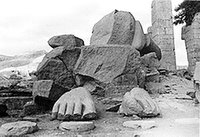Benjamin's interest here is in the Baroque--though, more abstractly still, he is reading modernity through the Baroque, and the Baroque work of art as an allegory for the work of art in general. But it is with Romanticism that the ruin really comes into its own.
Or rather, the point of a ruin is the extent to which it falls short of "its own," the extent to which it is non-coincident with the structure that it implies. And Romanticism takes particular note of that discrepancy between the absent presence of the material trace and the present absence of the sublime that it invokes in its very default.
 In invoking totality and sublimity, ruins have been read as particularly vivid allegories of power and sovereignty--and their vicissitudes. Take, for instance, Shelley's "Ozymandias." Here the poet relates the tale of a traveller coming across a desert ruin, the toppled remains of a vast sculpture of power. On its pedestal
In invoking totality and sublimity, ruins have been read as particularly vivid allegories of power and sovereignty--and their vicissitudes. Take, for instance, Shelley's "Ozymandias." Here the poet relates the tale of a traveller coming across a desert ruin, the toppled remains of a vast sculpture of power. On its pedestalthese words appear:The levels of allegory and irony are complex. The inscription, for instance, with its injunction to despair, was presumably first intended to be interpreted in terms of the king's transcendent and overarching authority. Yet the mighty could now be tempted to despair for quite another reason: because in the fallen desolation of the broken monument they can perceive the temporary nature of even the most overweening despotism. But, in yet another twist, the fact that this missive, however ruined, endures even as all around the civilization over which Ozymandias presided has faded without trace, could also be seen to bear out the truth of the sentiment: that the signs of transcendence prevail over the most calamitous of social and natural catastrophes.
"My name is Ozymandias, king of kings:
Look on my works, ye Mighty, and despair!"
Nothing beside remains. Round the decay
Of that colossal wreck, boundless and bare
The lone and level sands stretch far away. (11)
In other words, long after all memory of his kingdom has disappeared, long after all detail of the social order that he secured has faded into the real of this desert, we still remember the name of Ozymandias. The ruin ensures (to paraphrase Benjamin again) that his legacy has transcended history, by becoming immanent with nature itself. "In the ruin history has physically merged into the setting" (177-178). This is Ozymandias's final triumph.
And this is thanks to the power of narrative, which again here is multilayered. We have not only the inscription--which itself implies a prior order, the imperative of temporal power. We also have the fact that Shelley's poem consists almost entirely (all bar the first line) of the reported speech of an un-named "traveller from an antique land." Whose account is then repeated, recorded and enshrined, in published verse.
So here's the challenge: is there any way to resist the lure of narrative? To undo the symmetry between ruin and allegory? To see, in short, the ruin in itself, rather than as sign of an uninterrupted idea of sovereignty?
No comments:
Post a Comment